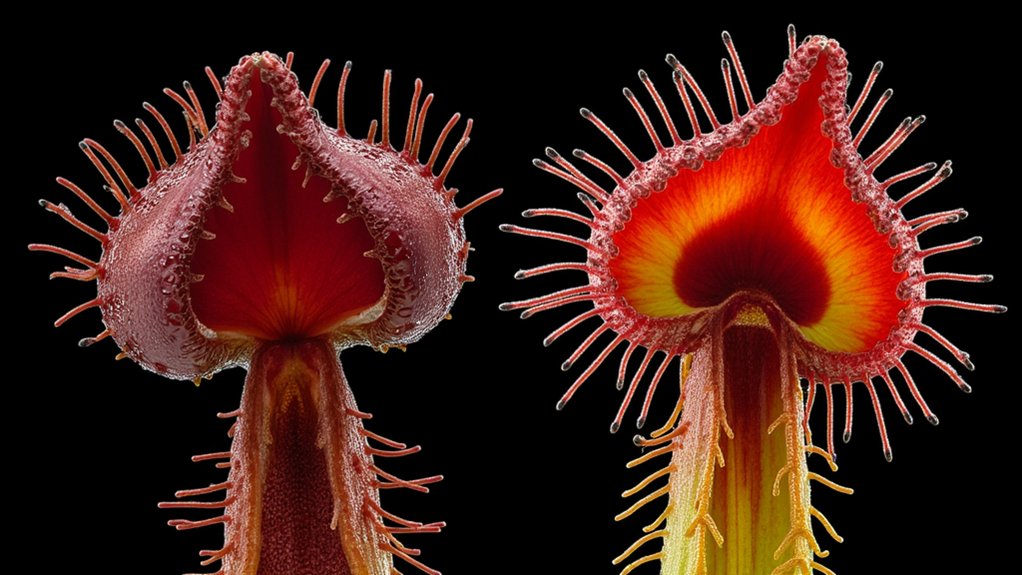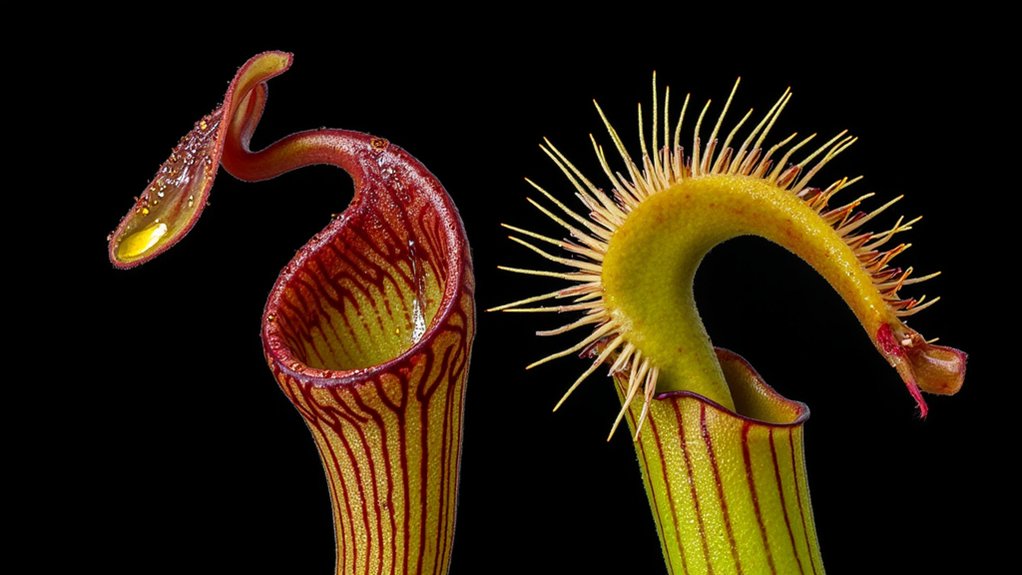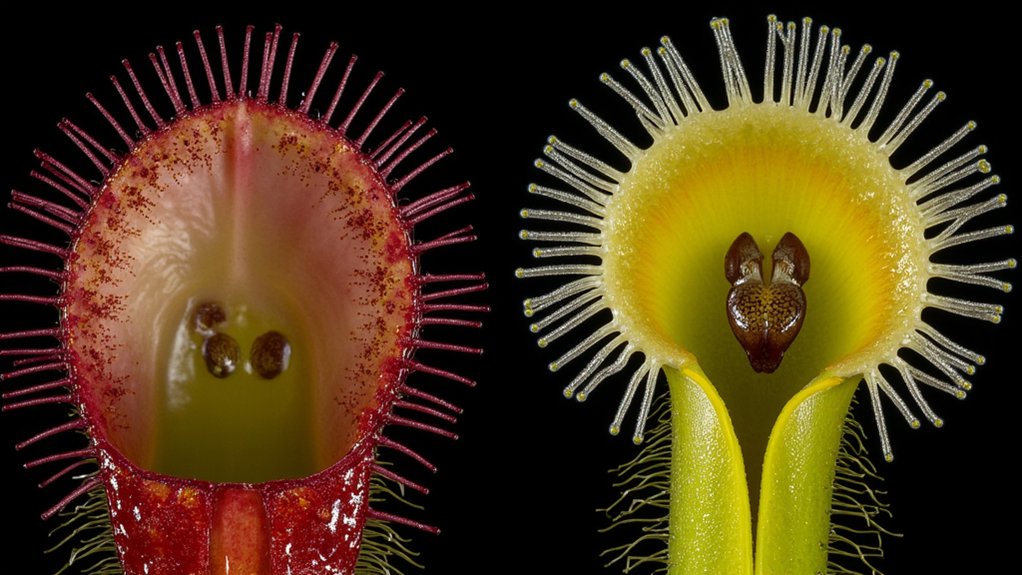In the dense swamps of Southeast Asia, pitcher plants convert up to 70% of captured prey into usable nutrients, while sundews achieve an impressive 90% conversion rate with their sticky traps. You’ll discover these fascinating carnivorous plants have evolved distinct hunting strategies that showcase nature’s innovative solutions to nutrient-poor environments. The real question isn’t just which plant catches more prey, but rather how their specialized adaptations create unique advantages in their constant quest for survival.
Contents
The Evolution of Plant Carnivory

Although plants are typically thought of as passive organisms, the fascinating world of carnivorous plants shows how some species evolved to become active hunters. You’ll find these adaptations emerging independently at least six times over the past 70 million years, often in nutrient-poor environments.
When you look at carnivorous plants today, you’re seeing the results of modified leaf structures that developed specialized features. Their leaves transformed into sophisticated traps, like the pitcher plant’s deep vessels and the sundew’s sticky tentacles, complete with digestive enzymes that break down prey.
These plants haven’t stopped evolving – they’re constantly fine-tuning their trapping mechanisms to catch insects more efficiently.
Anatomy of Nature’s Living Traps

The remarkable hunting tools of carnivorous plants come in two distinct designs that you’ll want to examine closely. Pitcher plants feature deep, fluid-filled tubes with slippery inner walls, while sundews utilize sticky tentacles arranged in rosette patterns.
You’ll find pitcher plants’ traps ranging from 2 to 30 inches deep, lined with downward-pointing hairs that prevent prey’s escape. Their digestive fluid contains enzymes that break down insects within 24-48 hours.
Sundews’ traps work differently, with each leaf sporting up to 200 hair-like tentacles tipped with glistening mucilage. When prey touches these adhesive droplets, nearby tentacles curl inward within 20 minutes.
Hunting Mechanisms Compared

While both carnivorous plants actively hunt for prey, their capture methods couldn’t be more different. Pitcher plants rely on passive trapping, using slippery nectar-coated rims and deep, water-filled chambers where insects drown and dissolve. You’ll find their digestive enzymes are concentrated at the bottom of these natural pitfall traps.
Sundews, however, employ a more aggressive strategy. Their leaves are covered in sticky tentacles that detect movement and curl around prey within 20 seconds of contact. When you examine these tentacles closely, you’ll notice they secrete both adhesive mucilage and digestive enzymes, making them efficient predators that can catch multiple insects simultaneously.
Prey Capture Success Rates
Different hunting strategies lead to varying levels of hunting success between these carnivorous competitors. You’ll find that pitcher plants typically capture prey 60-80% of the time when insects venture near their rim, while sundews average a 40-50% success rate with their sticky traps.
Don’t let these numbers fool you, though. Sundews make up for their lower capture rate by targeting smaller, more abundant insects. They’ll catch 20-30 prey items daily, while pitcher plants might snag 3-5 larger victims in the same period.
When measuring total biomass consumed, you’re looking at roughly equal amounts between the two species.
Digestive Enzyme Analysis
Both carnivorous plants secrete complex digestive enzymes, but you’ll find striking differences in their chemical compositions. Pitcher plants rely heavily on aspartic proteases and chitinases, which break down proteins at an ideal pH of 2-4. You’ll notice their digestive fluid is markedly more acidic than sundews’.
When you examine sundews, you’ll discover they produce a broader spectrum of enzymes, including phosphatases and amylases. Their sticky secretions maintain a pH of 4-5, making them less acidic but more efficient at processing smaller prey. While pitcher plants take 5-7 days to digest prey, sundews complete the process in just 2-3 days.
Nutrient Absorption Efficiency
Since each plant has evolved distinct digestive mechanisms, you’ll find fascinating differences in how effectively they absorb nutrients from their prey. Pitcher plants typically extract 70-80% of available nitrogen from insects within 6-8 days, while sundews complete their absorption in just 2-4 days.
You’ll notice sundews are more efficient at phosphorus uptake, absorbing up to 90% of available phosphorus through their sticky tentacles. Pitcher plants, however, only manage to extract 50-60% of phosphorus from their prey. The trade-off? Pitcher plants can process larger prey items, compensating for their lower absorption rates through sheer volume.
Environmental Adaptations
While harsh conditions drive most plants away, carnivorous plants have developed remarkable ways to thrive in nutrient-poor environments. You’ll find pitcher plants flourishing in waterlogged soils with pH levels between 4 and 5, while sundews adapt to both wet and dry conditions.
Pitcher plants develop deep roots and modified leaf structures that can hold up to 500ml of digestive fluid, allowing them to survive periodic flooding. Sundews, meanwhile, have developed sticky tentacles that can function in temperatures from 20°F to 100°F, and they’ll even go dormant during extreme conditions.
Both species can photosynthesize effectively in low-light conditions, making them versatile survivors in challenging habitats.
Energy Cost of Predation
Adapting to challenging environments requires careful energy management, and carnivorous plants face unique metabolic trade-offs. You’ll find that pitcher plants invest heavily in creating their traps early on, but they’re quite efficient once established, using minimal energy to digest prey.
Sundews, on the other hand, must constantly produce sticky digestive enzymes, which costs them up to 30% more energy than pitcher plants. They’ll expend additional resources moving their tentacles to capture prey, though you can observe this fascinating process happening within 20 seconds of contact.
When comparing their strategies, pitcher plants generally come out ahead regarding energy efficiency.
Seasonal Performance Patterns
Throughout the changing seasons, both pitcher plants and sundews display distinct patterns of predatory activity. You’ll notice pitcher plants peak in spring and early summer, catching up to 80% of their yearly prey between April and July, when flying insects are most abundant.
Sundews, however, maintain more consistent capture rates across their growing season. They’re able to snag prey from March through October, with only a 30% variation between peak and low periods. You’ll find they’re particularly effective during humid summer days when their sticky dew droplets remain fresh and attractive to crawling insects.
Impact on Local Ecosystems
Because both pitcher plants and sundews actively trap insects, they’ve become integral players in their local food webs. You’ll find they help regulate pest populations, particularly mosquitoes and flies, in wetland areas.
In your local bog, you’ll notice pitcher plants create microhabitats within their tubes, where small organisms thrive in a complex digestive ecosystem. Sundews, meanwhile, affect a wider radius by catching airborne insects across the ground layer.
When you’re studying these plants’ environmental impact, you’ll discover they’re selective predators – they won’t greatly harm beneficial pollinator populations, as they typically catch smaller insects under 15 millimeters.
